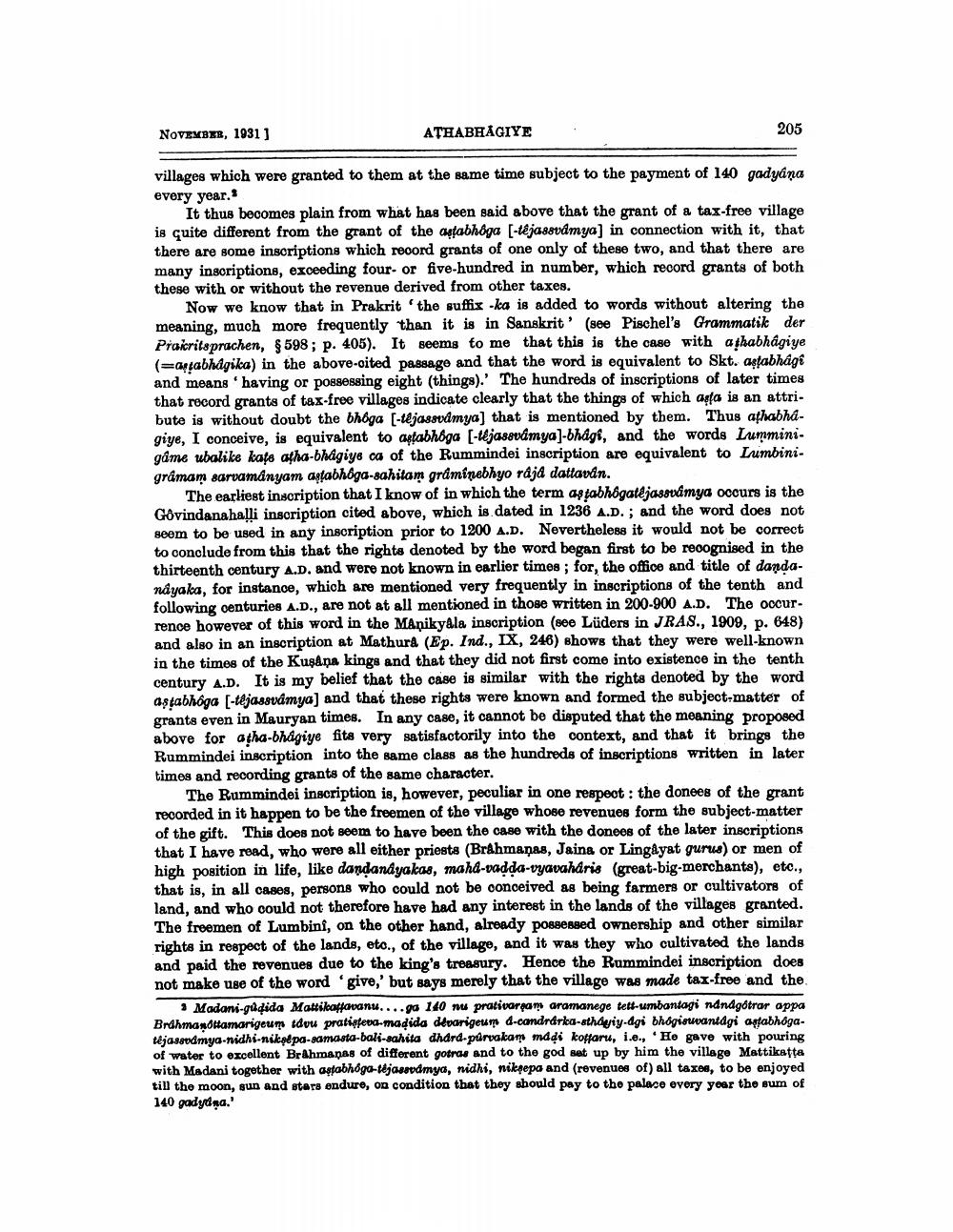________________
NOVEMBER, 1931)
ATHABHAGIYE
205
villages which were granted to them at the same time subject to the payment of 140 gadyana every year.
It thus becomes plain from what has been said above that the grant of a tax-free village is quite different from the grant of the aptabhoga [-tējasevdmya) in connection with it, that there are some inscriptions which record grants of one only of these two, and that there are many inscriptions, exceeding four or five-hundred in number, which record grants of both these with or without the revenue derived from other taxes.
Now we know that in Prakrit 'the suffix -ka is added to words without altering the meaning, much more frequently than it is in Sanskrit' (see Pischel's Grammatik der Prakritsprachen, $598; p. 405). It seems to me that this is the case with a thabhagiye (=wabhagika) in the above-cited passage and that the word is equivalent to Skt. astabhági and means 'having or possessing eight (things).' The hundreds of inscriptions of later times that record grants of tax-free villages indicate clearly that the things of which arfa is an attribute is without doubt the bhoga [-ujassvdmya] that is mentioned by them. Thus athabhagiye, I conceive, is equivalent to astabhoga [-tējasevdmya)-bhdge, and the words Lummini. game ubalike kafs atha-bhágiye ca of the Rummindei inscription are equivalent to Lumbini. grâmam sarvamanyam axtabhoga-sahitam gråminebhyo raja dattavin.
The earliest inscription that I know of in which the term astabhogatējassamya oocurs is the Govindanahalli inscription cited above, which is dated in 1236 A.D.; and the word does not seem to be used in any inscription prior to 1200 A.D. Nevertheless it would not be correct to conclude from this that the rights denoted by the word began first to be recognised in the thirteenth century A.D. and were not known in earlier times; for, the office and title of dandandyaka, for instance, which are mentioned very frequently in inscriptions of the tenth and following centuries A.D., are not at all mentioned in those written in 200-900 A.D. The occur. rence however of this word in the Manikyala inscription (see Lüders in JRAS., 1909, p. 648) and also in an inscription at Mathura (Ep. Ind., IX, 246) shows that they were well-known in the times of the Kuşana kings and that they did not first come into existence in the tenth century A.D. It is my belief that the case is similar with the rights denoted by the word astabhoga [-tējassvámya) and that these rights were known and formed the subject matter of grants even in Mauryan times. In any case, it cannot be disputed that the meaning proposed above for atha-bhägiye fits very satisfactorily into the context, and that it brings the Rummindei inscription into the same class as the hundreds of inscriptions written in later times and recording grants of the same character.
The Rummindei inscription is, however, peculiar in one respect : the donees of the grant recorded in it happen to be the freemen of the village whose revenues form the subject matter of the gift. This does not seem to have been the case with the donees of the later inscriptions that I have read, who were all either priests (Brahmaņas, Jaina or Lingayat gurus) or men of high position in life, like dandandyakas, maha-vadda-vyavahäris (great-big-merchants), etc., that is, in all cases, persons who could not be conceived as being farmers or cultivators of land, and who could not therefore have had any interest in the lands of the villages granted. The freemen of Lumbini, on the other hand, already possessed ownership and other similar rights in respect of the lands, eto., of the village, and it was they who cultivated the lands and paid the revenues due to the king's treasury. Hence the Rummindei inscription does not make use of the word 'give,' but says merely that the village was made tax-free and the
3 Madani-gudida Mattilafravanu....ga 140 m prativarpan aramanege tett umbandagi ndndgótrar appa Brdhmanottamarigeum idvu pratifea-madida déparigeum d-cand drka-sthagiy.dgi bhogistwantdgi astabhoga. të jassvdmya-nidhi-nikspa-samasta-bali-sahita dhard-púrvakam mddi koffari, 1.o., 'He gave with pouring of water to excellent Brahmanas of different gotras and to the god set up by him the village Mattikatta with Madani together with a tabhóga-tejasaudmya, nidhi, niknepa and (revenues of) all taxoe, to be enjoyed till the moon, sun and stars onduro, on condition that they should pay to the palace every year the sum of 140 gadydņa.'




